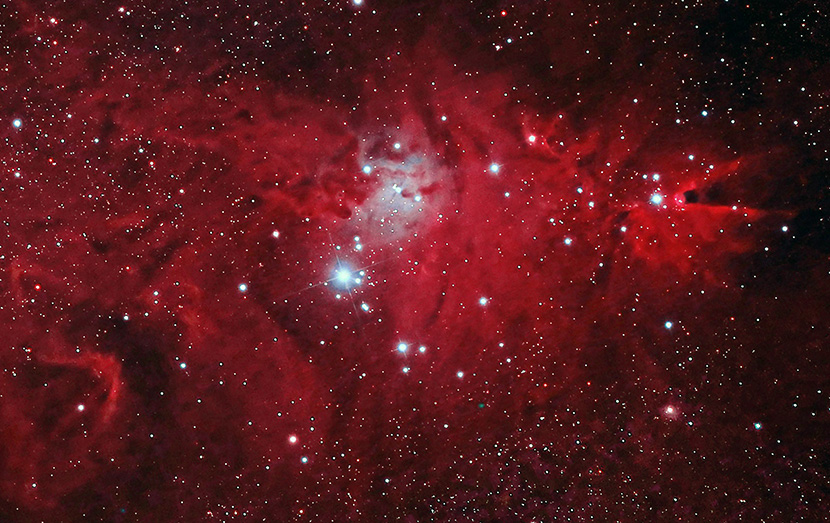Klaus
Yes

The Cone Nebula - Celestron 11 and TBM 130
© 2018 Klaus Brasch
NGC-2264 includes both the so-called Christmas tree cluster and the Cone Nebula and is located about 2600 light years in Monoceros. This expansive star forming region is a very colorful object photographically combining both red emission and blue reflection H-alpha components. This image is a composite mosaic of a total of 25 x 3-5 minute exposures taken over several years with TMB-130 and AP-155 refractors and 12.5-inch CDK, all with a Hutech modified Canon 6D and IDAS LPS-V4 at ISO 3200-6400. Images were stacked and calibrated in Registar and processed in Photoshop CS6.
The following was retrieved from Wikipedia, the free encyclopedia, at
http://en.wikipedia.org/wiki/Cone_Nebula
on March 1, 2014
The Cone Nebula
"The Cone Nebula is an H II region in the constellation of Monoceros. It was discovered by William Herschel on December 26, 1785, at which time he designated it H V.27. The nebula is located about 830 parsecs or 2,700 light-years away from Earth. The Cone Nebula forms part of the nebulosity surrounding the Christmas Tree Cluster. The designation of NGC 2264 in the New General Catalogue refers to both objects and not the nebula alone.
The diffuse Cone Nebula, so named because of its apparent shape, lies in the southern part of NGC 2264, the northern part being the magnitude-3.9 Christmas Tree Cluster. It is in the northern part of Monoceros, just north of the midpoint of a line from Procyon to Betelgeuse.
The cone's shape comes from a dark absorption nebula consisting of cold molecular hydrogen and dust in front of a faint emission nebula containing hydrogen ionized by S Monocerotis, the brightest star of NGC 2264. The faint nebula is approximately seven light-years long (with an apparent length of 10 arcminutes), and is 2,700 light-years away from Earth.
The nebula is part of a much larger star-forming complex—the Hubble Space Telescope was used to capture images of forming stars in 1997.
The nebula is sometimes referred to as the Jesus Christ Nebula because of its resemblance to Jesus with his hands in a prayer position."
The license terms of this written work from Wikipedia may be found at http://creativecommons.org/licenses/by-sa/3.0/
Outreach || Flagstaff || Photos || Articles || Observing Sites || Weather
Coordinated Universal Time || National Weather Service
info@coconinoastro.org

